HOME | ABOUT US | MEDIA KIT | CONTACT US | INQUIRE
HOME | ABOUT US | MEDIA KIT | CONTACT US | INQUIRE
December 2021
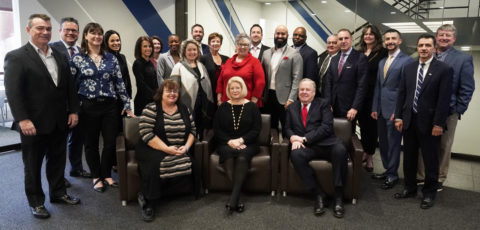
(Seated, left to right) Mary Esselman, Operation Breakthrough Marlys Haverty, Philanthropist of the Year Mick Haverty, Philanthropist of the Year (Standing, left to right) Bob Dunn, Dunn Family Foundation/JE Dunn Ron Coker, Burns & McDonnell (Co-Chair) Stephanie Guerin, Buckingham Strategic Wealth Shanna Adamic, Cerner Charitable Foundation Debbie Wilkerson, Greater Kansas City Community Foundation Kim Gasper, Harvesters Qiana Thomason, Health Forward Foundation Natasha Kirsch, The Grooming Project Kieth McGovern, BKD, LLP Janet Baker, Shepherd’s Center Terri Goddard, Shepherd’s Center Tony Kline, United Way of Greater Kansas City Chris Rosson, United Way of Greater KC (Co-Chair) Bill Johnson, KC Board of Public Utilities David Mehlhaff, KC Board of Public Utilities George Guastello, Union Station Kansas City Alex Kuebler, The Salvation Army Zalman Kohen, Summit Homes Michael Castino, Security Benefit Corp. Karl Ploeger, City Union Mission
The discussion began with some lighter moments that belied the serious nature of the topics to come. First off was a question to all: If you were the czar of philanthropy in the Kansas City region, what would be your first directive? In terms of philanthropic administration, that’s the equivalent of asking young children what they want for Christmas. Participants produced a long and varied list for Santa.
Kieth McGovern of accounting-consulting firm BKD would push for a sort of local Peace Corps of recent college graduates to engage in a year of volunteer service, while Mary Esselman of Operation Breakthrough said she would “invest more in our youngest learners.”
Said Security Benefit Corp.’s Michael Castino, “we’re big believers in private charities—effective organizations that are close to the community, and I’d like to see more done in that area.” Qiana Thomason of Health Forward Foundation said she’d wave her wand to produce more trust-based relationships and seek to engage those who are closest to the problems.
 Debbie Wilkerson of the Greater Kansas City Community Foundation said she’d like to see greater giving in all areas. At Buckingham Strategic Wealth, Stephanie Guerin said she’d establish a powerful lobbying force at the state and local level to advocate for money to go into non-profits, which she says are being asked “to do too much.”
Debbie Wilkerson of the Greater Kansas City Community Foundation said she’d like to see greater giving in all areas. At Buckingham Strategic Wealth, Stephanie Guerin said she’d establish a powerful lobbying force at the state and local level to advocate for money to go into non-profits, which she says are being asked “to do too much.”
Karl Ploeger at City Union Mission had a simple wish: To work in a post-COVID environment, as the current dynamic is a particular challenge for housing significant numbers of the homeless. At Summit Homes, Kristi Pinnick would direct more funding to education, while her colleague, Chelsea Fanders, said she was “all about the puppies,” and would press for more robust animal-welfare efforts.
Their COO, Zalman Kohen, would see more people inspired to give. “That would make a very impactful change in society,” he said. Kim Gasper at Harvesters—The Community Food Network, would like to see more collaborative efforts around solving challenges, and more trust with regard to administration of undesignated support.
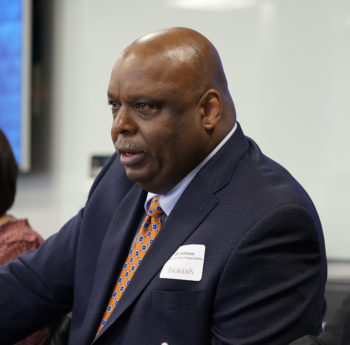 Bill Johnson, who leads the Kansas City Board of Public Utilities, would look for additional ways to resolve the most persistent community needs. “There are a lot to still be addressed,” he said. His communications officer, David Mehlhaff, also called for a focus on youth and youth engagement to embrace the value of giving back.
Bill Johnson, who leads the Kansas City Board of Public Utilities, would look for additional ways to resolve the most persistent community needs. “There are a lot to still be addressed,” he said. His communications officer, David Mehlhaff, also called for a focus on youth and youth engagement to embrace the value of giving back.
The Grooming Project’s Natasha Kirsch called for a more all-in approach to addressing long-term unemployment linked to homelessness, criminal backgrounds and lack of resources that allow people to lead productive lives—cell phones, for instance, and homes with working electrical systems to charge them.
Janet Baker at the Shepherd’s Center would redefine “family,” to give it a broader scope, one including parents and grandparents. “When we prioritize families,” she said, “we have to include older adults.” Her development director, Terri Goddard, needed only to look around the table to see that non-profit leadership needs to be more diverse and inclusive, especially in inviting those who need services to be part of the decision-making process in identifying needs from the patron’s perspective.
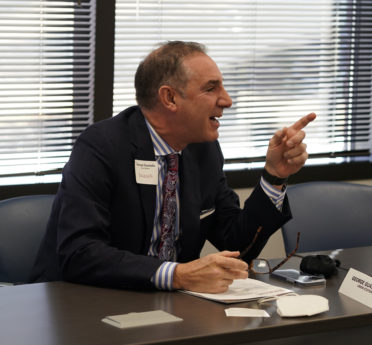 George Guastello, chief executive of Union Station, said the most important thing for all is to “ensure that our actions that we do every day speak louder than the words on the paper that we want to project all the time.” And, he added, that they should not allow the pandemic to define non-profit efforts.
George Guastello, chief executive of Union Station, said the most important thing for all is to “ensure that our actions that we do every day speak louder than the words on the paper that we want to project all the time.” And, he added, that they should not allow the pandemic to define non-profit efforts.
The United Way’s COO, Tony Kline would focus on child care and a paid jobs-training program. With both, he said, “we could jump start poverty and take care of a lot of downriver issues. His boss, CEO Chris Rosson, would “make sure everyone in the community, whether on the recipient end or the philanthropic end, understands that we all have a role to play.”
His wingman as assembly co-chair, Ron Coker of Burns & McDonnell, said “I would love it if we were all coordinated and cross-integrated in everything we do, because I think that’s where you get the most synergy.” His was a portentous comment that would touch on much of the two-hour discussion.
Next, Ron Coker asked about how non-profits had fared financially, given the national surge in philanthropic donations over the past two years.
At City Union Mission, said Karl Ploeger, “we had our best year ever in 2020, and we’re ahead of that pace in 2021.” That’s because a lot of people give out of perceived need, he said, and since the pandemic, the perception has become the reality. The need is palpable.
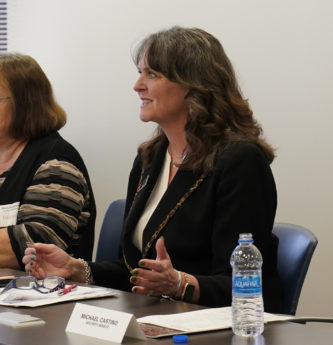 Alex Kuebler, as well, said it was a record-breaking year at the Salvation Army. “We have money to spend because we’ve got services to provide,” she said. Those services must now address the numbers of “new poor” who never thought they’d need what the Army provides, but “we’ve got the funds because we have an amazing community that stepped up” during the COVID-19 outbreak, she said.
Alex Kuebler, as well, said it was a record-breaking year at the Salvation Army. “We have money to spend because we’ve got services to provide,” she said. Those services must now address the numbers of “new poor” who never thought they’d need what the Army provides, but “we’ve got the funds because we have an amazing community that stepped up” during the COVID-19 outbreak, she said.
Operation Breakthrough has also seen a bump in donations, sufficient to increase the number of children served at the recent Christmas event by 25 percent, with 4,000 served this year, said Mary Esselman, the CEO there.
It has been, said Janet Baker of Shep-herd’s Center, a relieving year, in that support was there for basic programs, but what’s unique about it, she said, “and it’s a real conundrum to me, is that many funders in this room and foundations really understood the need to keep the doors open, the lights on and the people paid.” They released many of the usual restrictions on non-profits to provide services, and Baker acknowledged the rela-tive ease of raising money for causes that were easily observable.
“It’s harder to raise money for general operating,” Baker said, “and for a year, funders were able to understand that non-profits don’t make widgets.” Her concern is that in 2022, those restrictions will come back into place and compel difficult belt-tightening. Her Meals-on-Wheels program, for example, exploded from 50 deliveries pre-pandemic to more than 700, “and now I have to sustain that.”
Union Station, as well, had a banner year, George Guastello said. “It was a transformable year for us; it changed our organization to the better and to the good,” he said of the operation’s best financial year ever. As a 501(c)3, he said, the goal is to increase revenue and manage expenditures so that you have excess revenue that can go back to “stockholders”—the people you support. “Now, we are giving back to organizations that we partner with, and we’re becoming funders for organizations we partner with,” such as the Midwest Holocaust Center, he said.
 Chris Rosson said a concern for United Way was to track the long-term impact of the pandemic. “It was this moment, but for many families, there’s going to be a long-tail effect of that.” How are those in the service space thinking about addressing that need over time? And how has it shifted where funding is directed?” he asked.
Chris Rosson said a concern for United Way was to track the long-term impact of the pandemic. “It was this moment, but for many families, there’s going to be a long-tail effect of that.” How are those in the service space thinking about addressing that need over time? And how has it shifted where funding is directed?” he asked.
Qiana Thomason said the Health Forward Foundation would continue with more of its unrestricted funding, which would be one significant change. She also raised the emergence of diversity and equity issues as fundamental elements of the process, including in partnering with public-sector organizations to catalyze real solutions. Among those is its work with the Kansas City Council to launch an office of race and reconciliation.
Recognizing an equity component in all city issues—whether zoning and planning, where to build schools, criminal justice, health, housing—is essential, she said, and all have health implications that must be viewed through a racial-equity lens.
Governmental funding, in part, is shifting, said Mary Esselman, in cases of child-care funding, for example.
“For many industries, I don’t see the COVID bump” in revenues, said Zalman Kohen, and thus the pandemic experience has placed a new significance on the concept of corporate responsibility and the broader topic of giving back. That’s especially true, he said, because “the 2022 challenges will be no less than those 2021 brought.”
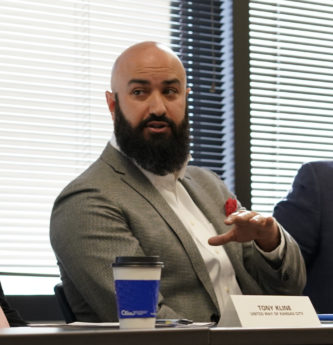 Chris Rosson acknowledged that many companies, even some non-profits, no longer exist after the pandemic downturn. “You either had a fantastic year, or a terrible year,” he said, and beyond the economic component came the social unrest of 2020, which also is reshaping non-profit missions.
Chris Rosson acknowledged that many companies, even some non-profits, no longer exist after the pandemic downturn. “You either had a fantastic year, or a terrible year,” he said, and beyond the economic component came the social unrest of 2020, which also is reshaping non-profit missions.
What’s transpired over the past two years compels non-profits to deepen their commitment to racial equity, said Qiana Thomason. “Race is often not
the problem, but racism is,” she said. “We have the power, at this table, to help redistribute the money in our community not only from a social perspective, but in the financial realm. Less than 1 percent of fund assets are managed by firms that are black- and brown-owned. We have the power to change that.”
To a degree, said Janet Baker, the social unrest has given her additional leeway as a leader to pursue diversification of her board and staff, with “zero resistance” to those efforts.
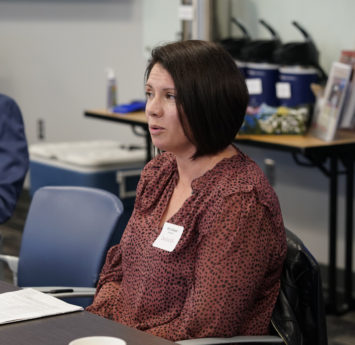 Kim Gasper said that if diversity and equity considerations are going to be fundamental elements in all aspects of non-profit decision-making, that will require better data, more real-time data and better tech tools to make some of those determinations. “We’re looking for a lot of the why and where” at Harvesters, she said.
Kim Gasper said that if diversity and equity considerations are going to be fundamental elements in all aspects of non-profit decision-making, that will require better data, more real-time data and better tech tools to make some of those determinations. “We’re looking for a lot of the why and where” at Harvesters, she said.
Funders especially need to look at a shift in philanthropy, said Stephanie Guerin, because the move to inclusion is not a matter of helping others; it’s helping ourselves, she said. “It’s in our own self-interest to have more diverse people at the table,” Guerin said. “White people benefit when there are more black and brown people at the table.”
Some huge problems are coming Kansas City’s way, Guerin said, just as they are to the nation, “and unless we’re tapping everybody’s brains, we’re not solving them. … We need the best minds, and we’re not going to get them if we’re leaving them at 31st and Troost, or if they can’t get a job because the don’t have cell phone or because they were raised by someone who’s 16 years old.”
Bill Johnson said the BPU wasn’t among those companies that saw a COVID boost; revenues at one point were down 16 percent. But the utility’s community commitment never wavered; it had one of the industry’s least-strident policies on service disconnects. During the ordeal, he said, the BPU re-examined diversity-supplier contracts and policies, with a goal of boosting small business. “Small business becomes big business, and they then are more capable of giving,” Johnson said.
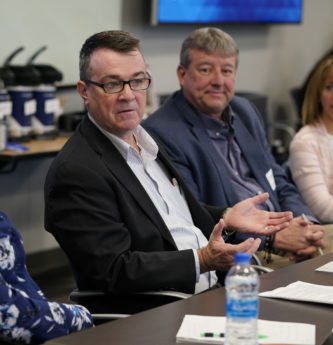 To the question of how corporate giving has affected younger employees, Shanna Adamic of the Cerner Charitable Foundation noted the parent company’s commitment to helping new hires invest in a giving culture. That’s something of particular importance with the penchant many younger workers have for job-hopping as they seek out organizations that align more with their personal values.
To the question of how corporate giving has affected younger employees, Shanna Adamic of the Cerner Charitable Foundation noted the parent company’s commitment to helping new hires invest in a giving culture. That’s something of particular importance with the penchant many younger workers have for job-hopping as they seek out organizations that align more with their personal values.
At JE Dunn Construction, said Bob Dunn, giving back has been a top priority since its founding nearly a century ago—and today, that has blossomed into support for more than 500 charities across the company. That works to the company’s advantage during hiring, he said, because many candidates make a decision about where they’ll work based on those corporate values. On top of that, he said, “people see volunteering as a way to get more training in leadership positions” within the company.
Is this community still as giving as in years past, when it was widely regarded as one of the nation’s top philanthropic centers?
That depends largely on the metrics used to measure giving, broadly. Debbie Wilkerson said one powerful indicator is that her community foundation was one of the two or three largest in the nation, in terms of assets, which means people here are donating here in disproportionately large amounts. The foundation’s growth, she said, had demonstrated that “giving is not just for the elite, but it’s welcomed and expected for everyone.”
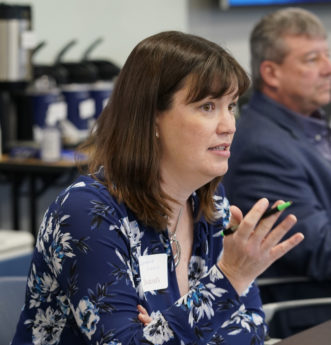 Wilkinson’s foundation in fact, is one reason why Kansas City enjoys the status it has in philanthropic circles,” said Stephanie Guerin. “The Kansas City Community Foundation has a nationwide reputation with everybody in wealth management,” she said. She frequently hears from out-of-town professionals that “you’re really lucky to be in Kansas City with a foundation that understands donor-advised funds and those types of gifts.”
Wilkinson’s foundation in fact, is one reason why Kansas City enjoys the status it has in philanthropic circles,” said Stephanie Guerin. “The Kansas City Community Foundation has a nationwide reputation with everybody in wealth management,” she said. She frequently hears from out-of-town professionals that “you’re really lucky to be in Kansas City with a foundation that understands donor-advised funds and those types of gifts.”
Proof of this community’s giving spirit was on full display with the COVID-19 Rapid Response Fund, which as set up within a month’s time early in the pandemic and yielded $18 million in that short span. What was just beautiful about that effort was the ‘how’ and the philanthropic process involved, said Qiana Thomason. Distribution of those funds, she said, “was probably the most equitable process I’ve ever seen, and that’s why the ‘how’ is just as important as the ‘how much?’”
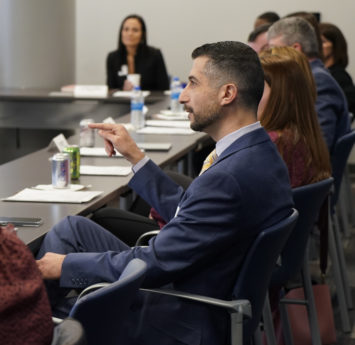 Zalman Kohen equated challenges for non-profits to those confronting the for-profit business community. Given that, business may have a greater opportunity to collaborate with those charitable efforts to create new synergies and efficiencies. “It goes beyond just striking a check, because anybody for the most part can do that, but how do you involve all team members from a variety of generations that we employ, and continue to retain, and attract new talent? I think people want to be part of organizations that give back and find meaningful purpose in what they do.”
Zalman Kohen equated challenges for non-profits to those confronting the for-profit business community. Given that, business may have a greater opportunity to collaborate with those charitable efforts to create new synergies and efficiencies. “It goes beyond just striking a check, because anybody for the most part can do that, but how do you involve all team members from a variety of generations that we employ, and continue to retain, and attract new talent? I think people want to be part of organizations that give back and find meaningful purpose in what they do.”
By some counts, the Kansas City region has more than 9,000 non-profit organizations and foundations. They address a wide range of concerns, but are they properly aligned?
“As generous as Kansas City is, are you all competing for the same funding?” asked Kim Gasper. “I think that’s when it becomes a challenge with funders who ask ‘how are you different from this?’”
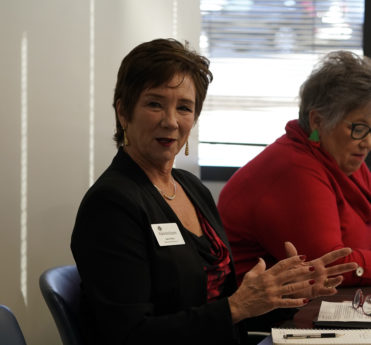 Janet Baker noted that there are still more non-profits than foundations, but she was curious about the foundation-funder dynamic and their processes for determining truly worthy causes. “It’s awful nice to give to a new non-profit, but at the same time, there are still so many dollars to go around.”
Janet Baker noted that there are still more non-profits than foundations, but she was curious about the foundation-funder dynamic and their processes for determining truly worthy causes. “It’s awful nice to give to a new non-profit, but at the same time, there are still so many dollars to go around.”
Chris Rosson was able to address a piece of that as one of the region’s biggest funders—United Way—and called the question “the core, the heart of what we have to grapple with.” He cited the wisdom of the late, great college basketball coach John Wooden, who famously said, “don’t confuse activity with achievement.”
“I have no doubt at all there’s enough collective philanthropic and generous effort in our community,” Rosson said. “I think the real question is whether as leaders—myself included—we are willing to set aside the egos, agendas and fief-doms and everything that we’ve built up that worked for us in strategic and important business ways, to get some-thing done together.”
Candidly, he said, “I think we’ve been part of the problem.” Funding leaders, he said, need to hold themselves accountable to ensure they are making the best investments with the highest possible yield against community need. He suggested that funding would be shifting to focus on more effective ROI.
But United Way has been a powerful example of the changes grounded in the quest for efficiency, noted Kieth McGovern. Fifteen years ago, the region was served by five United Way organizations; today, it operates as a unified entity, which has helped create a new focus. The same has gone on with numerous charities that, by coming together, qualify for state-level contracts they could never have received on their own.
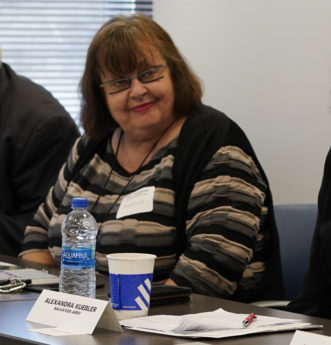 “We all need to get out of our own way,” said Mary Esselman. “Our mission is to do everything for everyone. But you know what? I don’t do food services; Harvesters does. We have family shelters, we don’t do individual shelters the best—you do,” she said, pointing City Union’s way with Karl Ploeger. She wondered whether the shuttering of some doors during the pandemic represented something of a right-sizing of non-profit service delivery.
“We all need to get out of our own way,” said Mary Esselman. “Our mission is to do everything for everyone. But you know what? I don’t do food services; Harvesters does. We have family shelters, we don’t do individual shelters the best—you do,” she said, pointing City Union’s way with Karl Ploeger. She wondered whether the shuttering of some doors during the pandemic represented something of a right-sizing of non-profit service delivery.
But a new era of collaboration, said Janet Baker, must start with agreed-upon goals. “If we’re going to get our egos out of the way, what are the community
priorities? Have we reduced poverty? Have we improved equity? Have we really improved minority economic development through employment? Have we really reduced obesity? To me, those are outcomes, the impact around which we really, truly never focused on or sustained our focus long enough to make a difference, because that’s not a one-year funding priority; that may be a 10-year community initiative.”
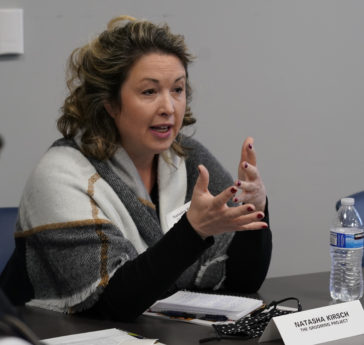 Natasha Kirch, of The Grooming Project, is one of the service providers attempting to address some of the underlying challenges that have defied such resolution. Her program to instruct the homeless and jobless with a marketable skill—pet grooming—has run smack into the issues of child care, transportation and basic life-skills deficits that have kept her students out of the work force.
Natasha Kirch, of The Grooming Project, is one of the service providers attempting to address some of the underlying challenges that have defied such resolution. Her program to instruct the homeless and jobless with a marketable skill—pet grooming—has run smack into the issues of child care, transportation and basic life-skills deficits that have kept her students out of the work force.
What she’s running into on all fronts, she said, was a lack of capacity. “The problem is, the demand is so high,” Kirsch said. There aren’t enough openings for children to be served at Operation Breakthrough; there isn’t enough transitional housing, she said. “We had 300 applications this year, and I only have 40 slots. We need other job-training programs. Not everyone wants to be a dog-groomer. I don’t want to be a dog-groomer.”
But what, she asked, if we had four or five, or 10 or 12 vocational training programs? “How do we get together and make this happen?”
Mick and Marlys Haverty, being honored as Philanthropist of the Year after the assembly, wound down the conversation with some observations from
the perspective of individual donors.
“There are just so many needs,” said Marlys Haverty. “So with non-profit organizations, the important thing we feel is education, and giving to schools, and
to churches.”
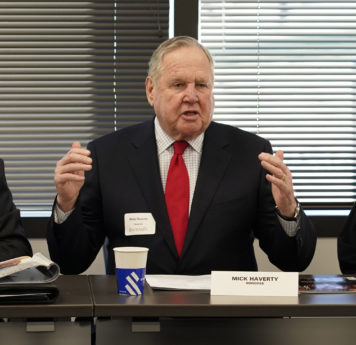 Mick Haverty brought things to a hopeful and optimistic conclusion by noting the deep history that his last paying position, Kansas City Southern Railway, had demonstrated as a corporate citizen, back to the leadership days of William Deramus and Landon Rowland. That model of corporate giving, he said, had served this community well for the better part of a century, and he expects that to continue with the looming merger that will create Canadian Pacific-Kansas City.
Mick Haverty brought things to a hopeful and optimistic conclusion by noting the deep history that his last paying position, Kansas City Southern Railway, had demonstrated as a corporate citizen, back to the leadership days of William Deramus and Landon Rowland. That model of corporate giving, he said, had served this community well for the better part of a century, and he expects that to continue with the looming merger that will create Canadian Pacific-Kansas City.
“I’m really not concerned,” Haverty said, “about any of the industries in Kansas City backing off in helping this community. This community is extremely important to every company here, and I think they’re going to continue giving.”